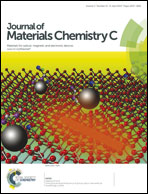Novel vertical spinning preparation of free-standing carbon nanotube–polyaniline composite films with high electrical conductivity†
Abstract
A novel vertical spinning (VS) process is reported for fabricating free-standing carbon nanotube (CNT)–polyaniline (PANI) composite films with high electrical conductivity (EC). In the VS process, a high centrifugal force is exerted on the PANI solution containing CNTs to achieve a uniform dispersion of CNTs in the composites; meanwhile, the high aspect ratio of CNTs is greatly maintained to a high degree (75%). These contribute to the high EC of the CNT–PANI films since the EC benefits from both the good dispersion and the high aspect ratio of CNTs. The EC of the as-prepared composite film with the 10 wt% CNTs has a value above 150 S cm−1, which is much higher than that at the same CNT content reported previously in the literature. For the purpose of comparison, the CNT–PANI composite films were prepared via the commonly used plane casting process. Moreover, the sandwich-structured PANI–CNT–PANI composite films were synthesized via the VS process to illustrate another advantage of this process in manipulating the distribution of fillers in the composites. The CNT–PANI composite films prepared by the VS process show the highest EC. The sandwiched structure shows a reasonably high conductivity and a relatively low percolation threshold among the three composite films.


 Please wait while we load your content...
Please wait while we load your content...